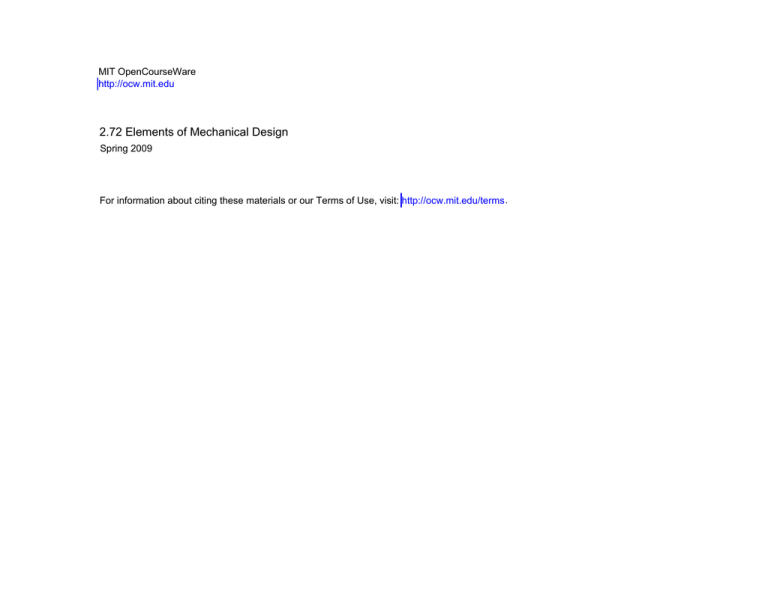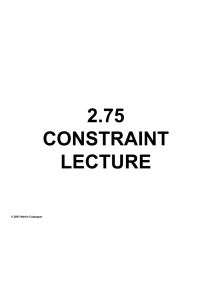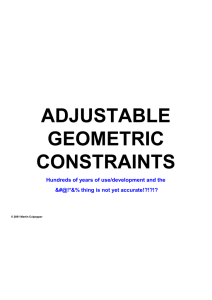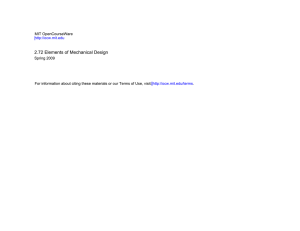
MIT OpenCourseWare
http://ocw.mit.edu
2.72 Elements of Mechanical Design
Spring 2009
For information about citing these materials or our Terms of Use, visit: http://ocw.mit.edu/terms.
2.72
Elements of
Mechanical Design
Lecture 09: Alignment
Schedule and reading assignment
Quiz
Thursday: Hale 6.1
Soon: Bolted joint qualifying quiz
Topics
Lab notebooks
Alignment methods
Kinematic coupling grade bump = ½ grade for use/design
Reading assignment
• Read: 8.2
• Examples: All in 8.2
© Martin Culpepper, All rights reserved
2
Lab notebooks
Technical quality/quantity
Appropriate equations, codes
Units
Important results highlighted/boxed/noted/explained
Graphical quality/quantity
Appropriate sketches/pictures
Pasted CAD/etc…
Archival quality
Can this be copied?
Understood by others?
Best practices
Dating and number of pages
Permanent pen
No blank spaces (X out)
© Martin Culpepper, All rights reserved
3
Ideal alignment interface
Repeatable
Accuracy
Stiffness (sensitive?)
Load capacity
6 DOF
“Perfect” constraint
Lowest energy state
Metal molds
High natural frequency
© Martin Culpepper, All rights reserved
4
Common alignment methods
Elastic averaging
Compliant kinematic Quasi-kinematic
Accuracy
Passive KC
Active kinematic
Repeatability
Passive kinematic
Accuracy & repeatability
repeatability
Active KC
Quasi-KC
Elastic C
Elastic A
Elastic B
Error
© Martin Culpepper, All rights reserved
Desired Position
Error
5
Pin-hole
6 DOF
Metal molds
© Martin Culpepper, All rights reserved
6
3 – 2 – 1 Alignment schemes
© Martin Culpepper, All rights reserved
7
Exact constraint couplings
Exact constraint (EC):
Constraints = DOF to be constrained
Deterministic saves $
Balls (inexpensive) & grooves (more difficult to make)
There are many
types of EC couplings,
our time limits us to a
semi-focused study on
kinematic couplings
In KC design the issues are:
KNOW what is happening in the system (coupling)
MANAGE forces, deflections, stresses and friction
Balls
Tetrahedral
groove
Maxwell
© Martin Culpepper, All rights reserved
V groove
Kelvin
8
Passive kinematic couplings
Fabricate and forget
¼ micrometer with best practices, 10s of nm recently
What is important?
Contact forces
Contact stress
Stiffness vs. geometry
Stiffness vs. preload
Friction & settling
Thermal loading
Preload repeatability
Preload
Preload (nesting load) is the force
applied to keep the coupling
components engaged and prevent
tipping
© Martin Culpepper, All rights reserved
9
Ball motions: Displacements
⎛
Fn ⎞⎟
9
⎜
= −⎜ ⋅
2
⎜ 16 Re ⋅ Ee ⎟⎟
⎠
⎝
2
v
Σδ n _ Ball _ iA
Hertz
1857-1894
1
3
v
⋅ nˆ Ball _ iA Σδ n _ Ball _ iB
Ball _ iA
v
v
⎛
Fn ⎞⎟
9
⎜
= −⎜ ⋅
2
⎜ 16 Re ⋅ Ee ⎟⎟
⎠
⎝
2
v
Σδ Ball _ i = δ Ball _ iA + δ Ball _ iB
1
3
⋅ nˆ Ball _ iB
Ball _ iB
This assumes
that the ball-ball
stiffness is > ~10x
ball-groove stiffness
Ball far-field point
v
B1
v
δ Ball _ iA
δ Ball _ iB
v
A
δ Ball _ i
B
Groove far-field points
© Martin Culpepper, All rights reserved
B2
B3
10
Load balance: Force and moment
Preload
Error
Force balance (3 equations)
Contact
v
v
v
v
v
v
v
v
v
ΣFrelative = 0 = (Fpreload + FError ) + (FBall _ 1 + FBall _ 2 + FBall _ 3 + FBall _ 4 + FBall _ 5 + FBall _ 6 )
Moment balance (3 equations)
(
) (
) (
)
r
r
r
r
v
v
v
v
v
v
6
M relative = Σ i =1 M Ball _ i + M preload + M error = (rpreload × Fpreload + rerror × FError ) + ΣrBall _ i × FBall _ i
Goal:
1. Solve 6 equations for contact forces
2. Solve normal displacements
3. Solve relative displacements/rotations
Given geometry, materials,
preload force, error force,
solve for local distance of approach
© Martin Culpepper, All rights reserved
Ball far-field point
A
B
Groove far-field points
11
Modeling round interfaces
Equivalent radius
1
R1major
+
1
1
R1min or
+
1
R2major
+
1
R2 min or
Equivalent modulus
Ee =
1
1− η1 1− η 2
+
E1
E2
2
2
⎛9
Fn ⎞
⎟
δ n = ⎜⎜ ⋅
2 ⎟
⎝ 16 Re ⋅ Ee ⎠
Poisson’s ratio
2
(
20
10
05
0
Young’s modulus
0
250
0.5
500
750
1000
Fn [N]
Degree of nonlinearity
is reduced as preload
is increased
1
3
Important scaling law
k n (δ n ) = 2 ⋅ Re
Contact stiffness
30
k [N/micron]
Re =
)
⋅ Ee ⋅ δ n
© Martin Culpepper, All rights reserved
0.5
Scaling with
Mat’l properties
and geometry
Preload should be
repeatable in magnitude
& direction
(
k n (Fn ) = Constant ⋅ Re 3 ⋅ Ee
1
2
3
)⋅ F
n
1
3
12
Friction and lubrication
Magnitude
depends on
coupling
design and
test
conditions
Displacement, μm
Wear in vs.
“snow balling”
Radial Repeatability (Unlubricated)
2
0
Number of Trials
Radial Repeatability (Lubricated)
Displacement, μm
The trend of
the data is
important
Slocum, A. H., Precision Engineering, 1988: Kinematic couplings for precision fixturing–
Experimental determination of repeatability and stiffness
2
0
Number of Trials
13
© Martin Culpepper, All rights reserved
Courtesy of Elsevier, Inc., http://www.sciencedirect.com. Used with permission.






